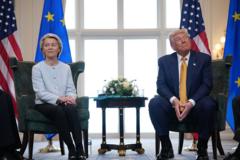The announcement of a trade agreement between the European Union and the United States, celebrated by European Commission chief Ursula von der Leyen and US President Donald Trump, has attracted simmering criticism from various European leaders. Though the agreement averts the previously threatened 30% tariffs on EU exports, many European nations remain skeptical about its long-term implications, with intricate details still pending clarification.
The newly established 15% tariff on most EU exports to the US, while less severe than initially feared, still represents a significant increase from the former average rate of 4.8%. This has not gone unnoticed among EU leaders, who feel dissatisfied with the outcomes, particularly regarding the lack of tougher negotiations on their part. German finance minister Lars Klingbeil remarked that despite the dissatisfaction with the deal, a sense of relief emerged from having at least secured an agreement with the US in a time of uncertainty.
Ongoing negotiations make it clear that the deal, still not legally binding, is just an initial step with further discussions required to address the minor yet important discrepancies in interpretation between the two sides. The US perspective indicates that pharmaceuticals and semiconductors will be subject to the 15% tariff, but the EU contends that these sectors will remain at 0% pending new agreement on global tariffs. The discord extends to proposed investment commitments, with the US claiming the EU "will" purchase significant amounts of US energy, while the EU concedes it merely "intends" to do so.
Various European economies are likely to bear the brunt of these tariffs unevenly. Countries like Germany, Ireland, and Italy are particularly vulnerable, as they account for a substantial portion of their exports to the US. For instance, Germany's automotive sector, which relies heavily on the US market, could face billions in additional costs due to the new tariffs. Irish officials, while recognizing the necessity of the agreement, expressed their discontent over the limitations imposed on exports, particularly pharmaceuticals.
As negotiations persist, it is evident that the path forward will be complicated. European leaders are under pressure to ensure their interests are adequately represented and that an unfavorable precedent is not set where European nations end up financing tariffs imposed by the US. The sentiment among some leaders is one of needing a stronger stance against the US in order to safeguard European economic interests. As the negotiations progress, the real winners and losers will emerge from these complex discussions.




















